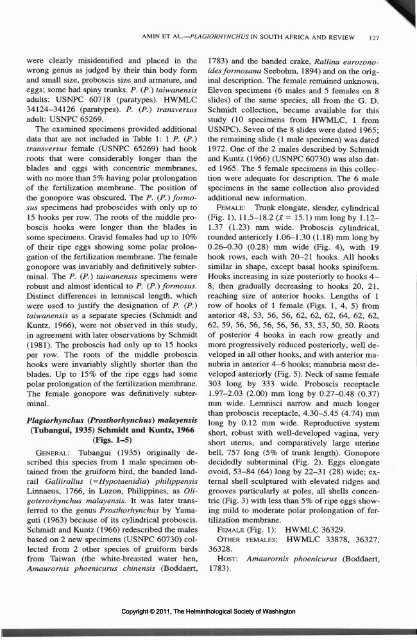The Helminthological Society of Washington - Peru State College
The Helminthological Society of Washington - Peru State College
The Helminthological Society of Washington - Peru State College
You also want an ePaper? Increase the reach of your titles
YUMPU automatically turns print PDFs into web optimized ePapers that Google loves.
AMIN ET AL.—PLAGIORHYNCHUS IN SOUTH AFRICA AND REVIEW 127<br />
were clearly misidentified and placed in the<br />
wrong genus as judged by their thin body form<br />
and small size, proboscis size and armature, and<br />
eggs; some had spiny trunks. P. (P.) taiwanensis<br />
adults: USNPC 60718 (paratypes). HWMLC<br />
34124-34126 (paratypes). P. (P.) transversus<br />
adult: USNPC 65269.<br />
<strong>The</strong> examined specimens provided additional<br />
data that are not included in Table 1: 1 P. (P.)<br />
transversus female (USNPC 65269) had hook<br />
roots that were considerably longer than the<br />
blades and eggs with concentric membranes,<br />
with no more than 5% having polar prolongation<br />
<strong>of</strong> the fertilization membrane. <strong>The</strong> position <strong>of</strong><br />
the gonopore was obscured. <strong>The</strong> P. (P.) formosus<br />
specimens had proboscides with only up to<br />
15 hooks per row. <strong>The</strong> roots <strong>of</strong> the middle proboscis<br />
hooks were longer than the blades in<br />
some specimens. Gravid females had up to 10%<br />
<strong>of</strong> their ripe eggs showing some polar prolongation<br />
<strong>of</strong> the fertilization membrane. <strong>The</strong> female<br />
gonopore was invariably and definitively subterminal.<br />
<strong>The</strong> P. (P.) taiwanensis specimens were<br />
robust and almost identical to P. (P.) formosus.<br />
Distinct differences in lemniscal length, which<br />
were used to justify the designation <strong>of</strong> P. (P.)<br />
taiwanensis as a separate species (Schmidt and<br />
Kuntz, 1966), were not observed in this study,<br />
in agreement with later observations by Schmidt<br />
(1981). <strong>The</strong> proboscis had only up to 15 hooks<br />
per row. <strong>The</strong> roots <strong>of</strong> the middle proboscis<br />
hooks were invariably slightly shorter than the<br />
blades. Up to 15% <strong>of</strong> the ripe eggs had some<br />
polar prolongation <strong>of</strong> the fertilization membrane.<br />
<strong>The</strong> female gonopore was definitively subterminal.<br />
Plagiorhynchus (Prosthorhynchus) malayensis<br />
(Tubangui, 1935) Schmidt and Kuntz, 1966<br />
(Figs. 1-5)<br />
GENERAL: Tubangui (1935) originally described<br />
this species from 1 male specimen obtained<br />
from the gruiform bird, the banded landrail<br />
Gallirallus (=Hypotaenidia) philippensis<br />
Linnaeus, 1766, in Luzon, Philippines, as Oligoterorhynchus<br />
malayensis. It was later transferred<br />
to the genus Prosthorhynchus by Yamaguti<br />
(1963) because <strong>of</strong> its cylindrical proboscis.<br />
Schmidt and Kuntz (1966) redescribed the males<br />
based on 2 new specimens (USNPC 60730) collected<br />
from 2 other species <strong>of</strong> gruiform birds<br />
from Taiwan (the white-breasted water hen,<br />
Amauromis phoenicurus chinensis (Boddaert,<br />
1783) and the banded crake, Rallina eurozonoides<br />
formosana Seebohm, 1894) and on the original<br />
description. <strong>The</strong> female remained unknown.<br />
Eleven specimens (6 males and 5 females on 8<br />
slides) <strong>of</strong> the same species, all from the G. D.<br />
Schmidt collection, became available for this<br />
study (10 specimens from HWMLC, 1 from<br />
USNPC). Seven <strong>of</strong> the 8 slides were dated 1965;<br />
the remaining slide (1 male specimen) was dated<br />
1972. One <strong>of</strong> the 2 males described by Schmidt<br />
and Kuntz (1966) (USNPC 60730) was also dated<br />
1965. <strong>The</strong> 5 female specimens in this collection<br />
were adequate for description. <strong>The</strong> 6 male<br />
specimens in the same collection also provided<br />
additional new information.<br />
FEMALE: Trunk elongate, slender, cylindrical<br />
(Fig. 1), 11.5-18.2 (Jc = 15.1) mm long by 1.12-<br />
1.37 (1.23) mm wide. Proboscis cylindrical,<br />
rounded anteriorly 1.06-1.30 (1.18) mm long by<br />
0.26-0.30 (0.28) mm wide (Fig. 4), with 19<br />
hook rows, each with 20-21 hooks. All hooks<br />
similar in shape, except basal hooks spiniform.<br />
Hooks increasing in size posteriorly to hooks 4-<br />
8, then gradually decreasing to hooks 20, 21,<br />
reaching size <strong>of</strong> anterior hooks. Lengths <strong>of</strong> 1<br />
row <strong>of</strong> hooks <strong>of</strong> 1 female (Figs. 1, 4, 5) from<br />
anterior 48, 53, 56, 56, 62, 62, 62, 64, 62, 62,<br />
62, 59, 56, 56, 56, 56, 56, 53, 53, 50, 50. Roots<br />
<strong>of</strong> posterior 4 hooks in each row greatly and<br />
more progressively reduced posteriorly, well developed<br />
in all other hooks, and with anterior manubria<br />
in anterior 4-6 hooks; manubria most developed<br />
anteriorly (Fig. 5). Neck <strong>of</strong> same female<br />
303 long by 333 wide. Proboscis receptacle<br />
1.97-2.03 (2.00) mm long by 0.27-0.48 (0.37)<br />
mm wide. Lemnisci narrow and much longer<br />
than proboscis receptacle, 4.30-5.45 (4.74) mm<br />
long by 0.12 mm wide. Reproductive system<br />
short, robust with well-developed vagina, very<br />
short uterus, and comparatively large uterine<br />
bell, 757 long (5% <strong>of</strong> trunk length). Gonopore<br />
decidedly subterminal (Fig. 2). Eggs elongate<br />
ovoid, 53-84 (64) long by 22-31 (28) wide; external<br />
shell sculptured with elevated ridges and<br />
grooves particularly at poles, all shells concentric<br />
(Fig. 3) with less than 5% <strong>of</strong> ripe eggs showing<br />
mild to moderate polar prolongation <strong>of</strong> fertilization<br />
membrane.<br />
FEMALE (Fig. 1): HWMLC 36329.<br />
OTHER FEMALES: HWMLC 33878, 36327,<br />
36328.<br />
HOST: Amauromis phoenicurus (Boddaert,<br />
1783).<br />
Copyright © 2011, <strong>The</strong> <strong>Helminthological</strong> <strong>Society</strong> <strong>of</strong> <strong>Washington</strong>
















